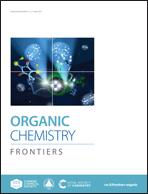Stereospecific cyanation of the olefinic C–H bond enabled by 1,4-rhodium migration†
Abstract
Rhodium-catalyzed stereospecific cyanation of the olefinic C–H bond using environmentally benign N-cyano-N-phenyl-p-methylbenzenesulfonamide (NCTS) as a cyanating reagent for the synthesis of β,β-disubstituted acrylonitriles has been developed. The mechanism involves electrophilic cyanation of an alkenylrhodium intermediate which is generated in situ via 1,4-rhodium migration. This approach does not require directing groups, tolerates various functional groups, and provides a concise and green access to a wide range of disubstituted acrylonitriles in generally good to excellent yields under mild conditions.



 Please wait while we load your content...
Please wait while we load your content...